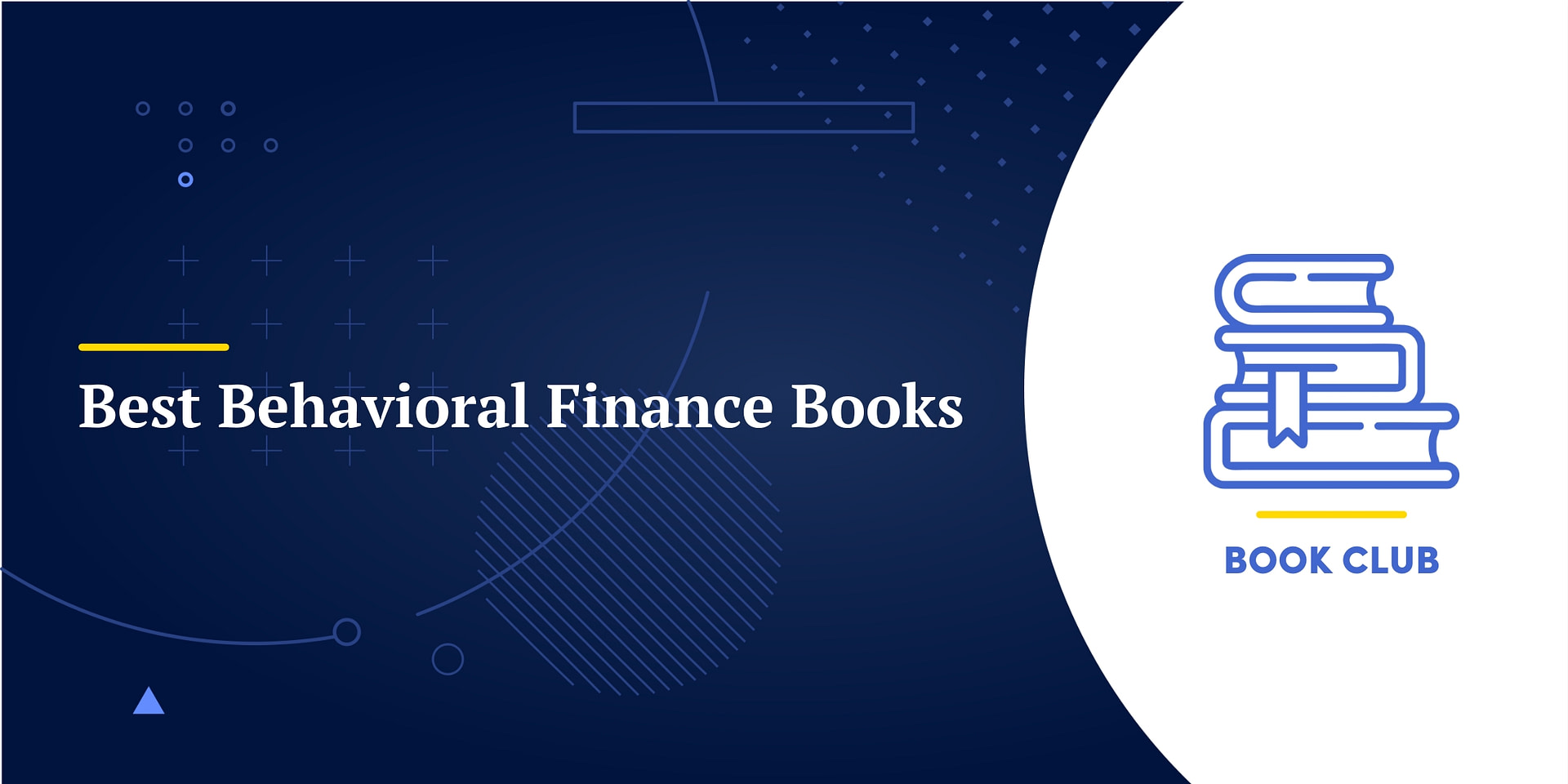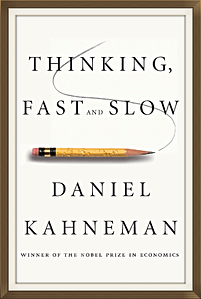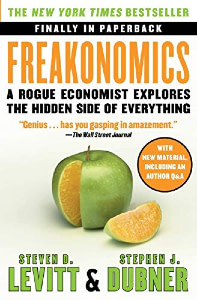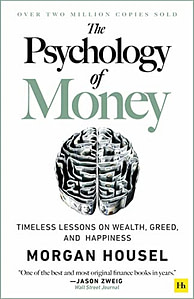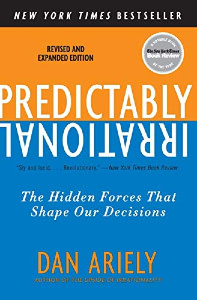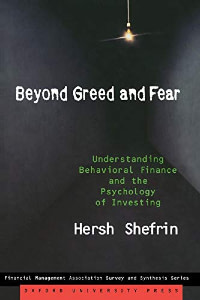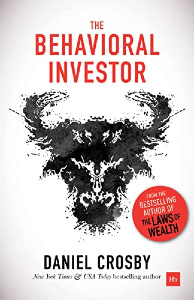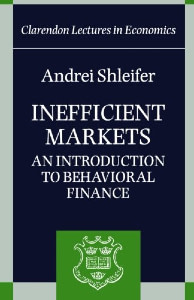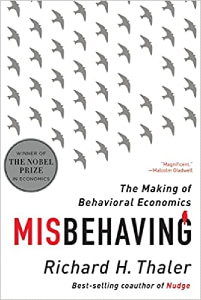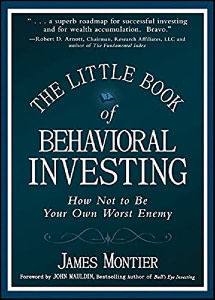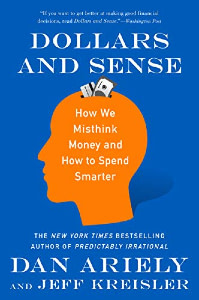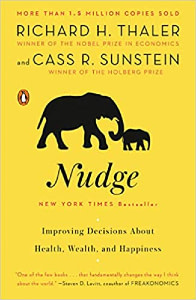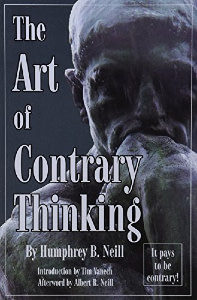Buyers usually let feelings and biases information their monetary selections, main them to make careless errors. People managing their private funds additionally ceaselessly put cause and information within the backseat.
How are you going to grow to be extra acutely aware of danger, act in your finest curiosity, and forestall feelings and biases from getting the most effective of you? Behavioral finance books will help.
The next titles will educate you the right way to make rational selections and fewer errors, whether or not you’re managing private finance or investments.
by Daniel Kahneman
Pondering, Quick and Sluggish (2011) by Daniel Kahneman is among the many finest funding books for learners. It delves into cognitive biases and folks’s two conflicting modes of pondering: intuitive and deliberate.
It explains how processing info instinctively could be useful however usually results in errors in judgment. Placing feelings apart and permitting time for logical reasoning will help you make rational selections.
🔑 Key takeaways:
- Instinct and deliberation in behavioral economics;
- How overconfidence causes biased, subjective selections;
- Objectively processing and responding to statistical info;
- Prospect idea.
This best-seller’s main themes are the exploration of many cognitive biases and heuristics. Seize your copy to know the right way to overcome them and take cost of your monetary habits.
✍️ Concerning the creator: Daniel Kahneman is a world-renowned psychologist and economist well-known for his findings on behavioral economics, which earned him the 2002 Nobel Prize in Financial Sciences. He developed prospect idea, co-founded TGG Group, and teaches psychology and public affairs at Princeton College.
A Rouge Economist Explores the Hidden Aspect of Every part
by Stephen J. Dubner & Steven Levitt
Freakonomics (2005), by Stephen J. Dubner & Steven Levitt, is an uncommon guide that correlates economics and sociocultural phenomena. It explains methods so that you can apply financial idea to quite a few seemingly unrelated topics, together with popular culture.
The guide additionally discusses controversial concepts like abortion and gun violence, for which it has acquired criticism. Nevertheless, the authors tie them again to financial ideas with behavioral arguments.
🔑 Key takeaways:
- Financial information can appropriate the irrational habits governing our lives;
- We’d like economics to know human habits;
- Nature and nurture have an effect on how individuals behave;
- Releasing your self from typical pondering could make you a greater economist.
Freakonomics could be a difficult learn, however it’s price it in case you are something however conventional.
✍️ Concerning the authors: Steven Levitt is an economist who received the John Bates Clark Medal in 2003. He co-founded TGG Group and the Middle for RISC on the College of Chicago, the place he works as an economics professor.
Stephen J. Dubner is a journalist, creator, and host of the Freakonomics Radio podcast. He co-authored a number of Freakonomics sequels and has acquired many awards for his journalistic work.
Timeless Classes on Wealth, Greed, and Happiness
by Morgan Housel
The Psychology of Cash (2020), by Morgan Housel, isn’t your bizarre behavioral finance guide concentrating on investing and sensible ideas. It focuses on perceptions of cash and their affect on monetary decision-making.
The guide accommodates 19 brief tales that develop our understanding of economics, wealth, greed, success, and happiness, highlighting the affect of psychology on monetary selections.
🔑 Key takeaways:
- Be cheap as a substitute of rational;
- Embrace market volatility;
- Get monetary savings and anticipate profitable alternatives;
- Go away your ego out of the equation;
- Fastidiously plan investments and subsequent steps as a result of not all methods are successful.
This partaking learn additionally tackles private finance administration, instructing the readers in regards to the significance of smart spending and financial savings selections on the journey to wealth.
✍️ Concerning the creator: Morgan Housel is a monetary journalist and behavioral finance professional who used to jot down for the Wall Avenue Journal and the Motley Idiot. He’s a associate on the Collaborative Fund and has received quite a few awards, together with the SABEW’s Finest in Enterprise Award and the New York Instances Sydney Award.
The Hidden Forces That Form Our Choices
by Dan Ariely
Predictably Irrational (2008), by Dan Ariely. is a wonderful guide for newbie buyers and college students learning behavioral finance. It reads like a narrative, containing private anecdotes from on a regular basis experiences to assist readers delve into an investor’s thoughts.
Ariely makes use of thrilling experiments and real-life examples to indicate how individuals act irrationally, even when deliberately making an attempt to make a rational resolution.
🔑 Key takeaways:
- Irrational habits is systemic and predictable;
- Feelings stand in the way in which of fine judgment;
- Individuals put extra worth on free merchandise than they really have (the zero worth impact);
- We overvalue owned objects resulting from emotional biases (the endowment impact);
- Predicting irrational habits will help consider market sentiment.
In addition to its invaluable funding classes, this guide accommodates examples demonstrating that many individuals don’t use rational thought when evaluating costs. As an illustration, we might count on a dearer medication to be more practical than its reasonably priced counterpart, even when each are placebos.
Get your copy in case you are on the lookout for a thought-provoking learn which may enable you grow to be extra rational with funds.
✍️ Concerning the creator: Dan Ariely is a psychology and behavioral economics professor at Duke College, the place he runs the Middle of Superior Hindsight analysis lab. He taught at MIT, co-founded a number of corporations specializing in behavioral science, and has printed a number of best-sellers, together with Predictably Irrational and The Upside of Irrationality.
Understanding Behavioral Finance and the Psychology of Investing
by Hersh Shefrin
Past Greed and Concern (1999), by Hersh Shefrin, seems to be at how psychology influences monetary selections. Shefrin teaches buyers the right way to forestall feelings, bias, and overconfidence from clouding their judgment.
The guide delves into how we let errors improve our worry with out studying the teachings these errors can educate. After we assume we see revenue, we grow to be grasping and make the identical errors again and again. Buyers can overcome the cycle of greed and worry by recognizing and avoiding cognitive biases and errors.
🔑 Key takeaways:
- The ideas of heuristic biases, body dependence, and market inefficiency;
- Even seasoned professionals let feelings and cognitive biases information their actions;
- Funding fashions don’t contemplate these basic components of human habits;
- Ignoring the results of the psychology of investing results in errors and monetary losses.
It’s possible you’ll tie this guide’s themes to buying and selling, however its main focus is investing.
✍️ Concerning the creator: Hersh Shefrin is an economist specializing in behavioral finance. He’s a finance professor at Santa Clara College, the place he beforehand taught economics, and writes for the Wall Avenue Journal, Forbes, Vox, and Huffington Put up. He has printed many analysis articles and books and received the Albert Nelson Marquis Lifetime Achievement Award in 2019.
by Daniel Crosby
The Behavioral Investor (2018), by Daniel Crosby, is among the many prime must-read books for buyers. It delves deep into connections between human nature and finance and presents sensible ideas for higher monetary habits and better returns.
This guide will help you improve self-awareness, keep away from frequent funding pitfalls, overcome pure inclinations, enhance your portfolio administration and construct wealth.
🔑 Key takeaways:
- The psychological, neurological, and sociological elements impacting your funding selections;
- The 4 psychological tendencies (ego, conservatism, consideration, and emotion) influencing funding habits;
- Sensible options to those issues and wealth administration ideas.
The creator additionally proposes a rules-based behavioral investing (RBI) methodology for shifting away from emotional biases and towards rational, evidence-based decision-making.
✍️ Concerning the creator: Daniel Crosby is a psychologist, asset supervisor, and behavioral finance professional serving to corporations maximize funding returns and construct wealth. He’s a thought chief writing for Funding Information and WealthManagement.com and producing the “Irrationality Index,” which measures greed and worry to forecast detrimental returns.
An Introduction to Behavioral Finance
by Andrei Shleifer
The environment friendly market speculation (EMH) states that asset costs replicate all out there info and have honest basic values. It assumes that each one buyers are rational and that pricing discrepancy is inconceivable resulting from arbitrage alternatives.
That isn’t the case with real-world monetary markets. Institutional and psychological proof problem the EMH’s assumptions.
In Inefficient Markets (2000), Andrei Shleifer proposes behavioral finance instead, presenting empirical proof and theories for analyzing precise markets.
🔑 Key takeaways:
- Actual-world monetary markets are inefficient;
- Buyers make irrational selections resulting from cognitive biases;
- Behavioral finance helps precisely analyze monetary knowledge and forecast asset costs.
This guide is a wonderful learn for learners in behavioral finance. The creator’s simply intelligible explanations of assorted monetary market fashions assist newbies perceive and apply the information in actual life.
✍️ Concerning the creator: Andrei Shleifer is a monetary, behavioral, and growth economist, researcher, and creator. He received the John Bates Clark Medal in 1999, co-founded LSV Asset Administration, and taught at Princeton College and the College of Chicago. He has been an economics professor at Harvard College since 1991.
The Making of Behavioral Economics
by Richard H. Thaler
Richard H. Thaler’s titles are among the many Most worthy behavioral finance books. The Nobel laureate’s Misbehaving (2017) is a gripping guide you’ll need to learn in a single sitting as a result of the knowledge and infrequently humorous illustrations received’t allow you to put it down.
Thaler explains how individuals ceaselessly make irrational monetary selections as a result of they let emotional biases information their actions. They misbehave, and markets transfer irrationally consequently.
🔑 Key takeaways:
- Buyers are irrational and misbehave due to emotional biases;
- Misbehavior can have detrimental penalties;
- Behavioral economics gives a brand new lens to investigate financial idea;
The creator’s private experiences make the guide much more partaking. Seize your copy if you need an entertaining and insightful learn that may enable you make wiser monetary selections.
✍️ Concerning the creator: Richard H. Thaler is a behavioral economist, creator, and columnist for The New York Instances. He received the Nobel Prize in Financial Sciences in 2017 for excellent contributions to behavioral economics. He has been an economics and behavioral science professor on the College of Chicago’s Sales space College of Enterprise since 1995.
How To not Be Your Personal Worst Enemy
by James Montier
The Little Ebook of Behavioral Investing (2010), by James Montier, explains how human habits impacts monetary markets and presents tips on sustaining a worthwhile funding portfolio.
The creator shares insights into buyers’ psychological pitfalls, similar to feelings, hindsight bias, loss aversion, and overconfidence, and presents options to keep away from them. He additionally explains the importance of studying from errors and overcoming behavioral challenges.
🔑 Key takeaways:
- Cautious planning helps keep funding self-discipline;
- Guesswork and failing to be taught from errors can result in losses;
- Specializing in low-risk property helps overcome the worry of creating funding selections;
- Monitoring worth fluctuations will help you make worthwhile selections;
- Elementary evaluation is essential to find out honest market values.
This brief learn is good for aspiring buyers dipping their toes in monetary markets. It presents a helpful basis for making psychology work in your favor and breaking the obstacles hindering excessive returns.
✍️ Concerning the creator: James Montier is a famend economist with a number of behavioral and the creator of a number of investing books. He’s a fellow of the Royal Society of Arts and a visiting fellow on the College of Durham. He was the co-head of Normal Technique at Société Générale and at present works as an asset allocation supervisor at GMO.
How We Misthink Cash and Find out how to Spend Smarter
by Dan Ariely & Jeff Kreisler
{Dollars} and Sense (2017) is a page-turner that dives into the irrational world of non-public finance and gives steering on overcoming behavioral challenges. It’s a sensible choice for the reader who’s extra centered on private finance than on investing.
The authors discover on a regular basis matters to assist us perceive how feelings have an effect on our monetary decisions and will price us greater than we predict. They talk about how we understand cash and handle the tendencies driving us to spend greater than we should always, from utilizing bank cards for groceries to overpaying for objects on trip.
🔑 Key takeaways:
- How psychology impacts your monetary selections;
- Find out how to change your instincts for higher monetary decision-making;
- Sensible recommendation on enhancing monetary decisions, together with spending and saving extra properly.
This fulfilling learn explains behavioral finance in an easy-to-understand language, infusing humor into real-life examples to assist readers relate. It’s a fascinating behavioral finance guide for learners.
✍️ Concerning the authors: Behavioral economist Dan Ariely has partnered with Jeff Kreisler, a lawyer, creator, slapstick comedian, and behavioral science advocate. Kreisler is head of Behavioral Science at J.P. Morgan Chace, founding editor at PeopleScience, and an government humor coach at Stanford Enterprise College.
Bettering Choices About Well being, Wealth, and Happiness
by Richard H. Thaler & Cass R. Sunstein
Nudge (2008) is a improbable learn in regards to the behavioral patterns that lead us to poor monetary decisions, negatively affecting our well being, wealth, and happiness. It gives real-world situations and ideas to enhance our monetary habits.
The authors clarify how individuals succumb to biases when making monetary selections and share enlightening examples from intensive analysis on behavioral science.
🔑 Key takeaways:
- “Alternative structure” can change client habits by “nudging” individuals in the suitable course with out proscribing choices;
- Even a minor change can “nudge” individuals to make higher selections;
- Utilizing the nudge idea to revamp our surroundings will help us dwell higher lives.
The authors have rewritten this New York Instances best-seller to share new analysis and private experiences. Nudge: The Ultimate Version (2021) gives insights on private finance, bank card debt, mortgages, retirement financial savings, local weather change, medical care, and different areas the place we are able to make higher selections for a extra fulfilling life.
✍️ Concerning the creator: Behavioral economist and Nobel laureate Richard H. Thaler has teamed up with authorized scholar Cass R. Sunstein in a collaboration for Nudge. Sunstein labored for the Obama administration, received the Holberg Prize in 2018, and taught on the College of Chicago Legislation College. He at present teaches at Harvard Legislation College because the Robert Walmsley College Professor.
Paradoxes and Anomalies of Financial Life
by Richard H. Thaler
The Winner’s Curse (1991) is a captivating exploration of irrational financial habits. Thaler tackles many paradoxes and anomalies of on a regular basis financial life, explaining a standard phenomenon in monetary markets and worth auctions: the winner’s curse.
The winner’s curse is an financial anomaly indicating that the winner can also be a loser as a result of they overestimate an merchandise’s worth and infrequently overpay for it.
Thaler shares many real-world examples to help his knowledge, together with public sale bidders and customers saving cash on one product to spend the financial savings on one other.
🔑 Key takeaways:
- Why individuals make irrational monetary selections;
- Financial paradoxes and anomalies, primarily the winner’s curse;
- Monetary markets are inefficient.
This guide might reveal important financial knowledge, however it’s barely difficult for readers with no background in economics. It’s a dense guide with many mathematical examples that make it perfect for educational readers.
by Humphrey B. Neill
Do you comply with the pack as an investor or select an oppositional course? The previous could be dangerous, in response to the late Humphrey B. Neill.
“When everybody thinks alike, everyone seems to be flawed.”
This pearl of knowledge is one in all many this famend economist mentioned in The Artwork of Opposite Pondering (1976). He defined the results of herd mentality on funding selections and monetary markets and proposed a unique pondering philosophy he utilized when doing enterprise or investing.
Opposite pondering will help buyers seize the rising worth from others following of their footsteps. It may additionally assist forecast market shifts and forestall monetary losses.
🔑 Key takeaways:
- The herd is normally flawed;
- Opposite pondering will help you keep heading in the right direction;
- An oppositional technique will help you forestall or reduce losses.
This guide offers you a components for pondering like a profitable investor, making higher selections, leveraging worth, understanding how individuals behave, and producing correct forecasts. It’s nonetheless a related learn after almost half a century.
✍️ Concerning the creator: Humphrey B. Neill was an economist, funding thinker, and World Conflict I lieutenant. He devoted his life to analyzing and writing in regards to the folly of herd mentality and its results on funding selections. At all times encouraging individuals to query the consensus and offering mountains of proof, he earned the title “father of opposite opinion” from Life journal.
Conclusion
These behavioral finance books deserve a spot on each financially centered bookshelf, from buyers and asset managers to people in search of private finance recommendation.
Their knowledge and real-world examples could be invaluable instruments for worthwhile investments and higher financial selections devoid of feelings and biases.

